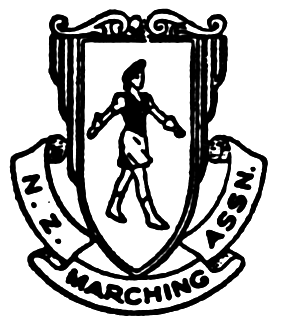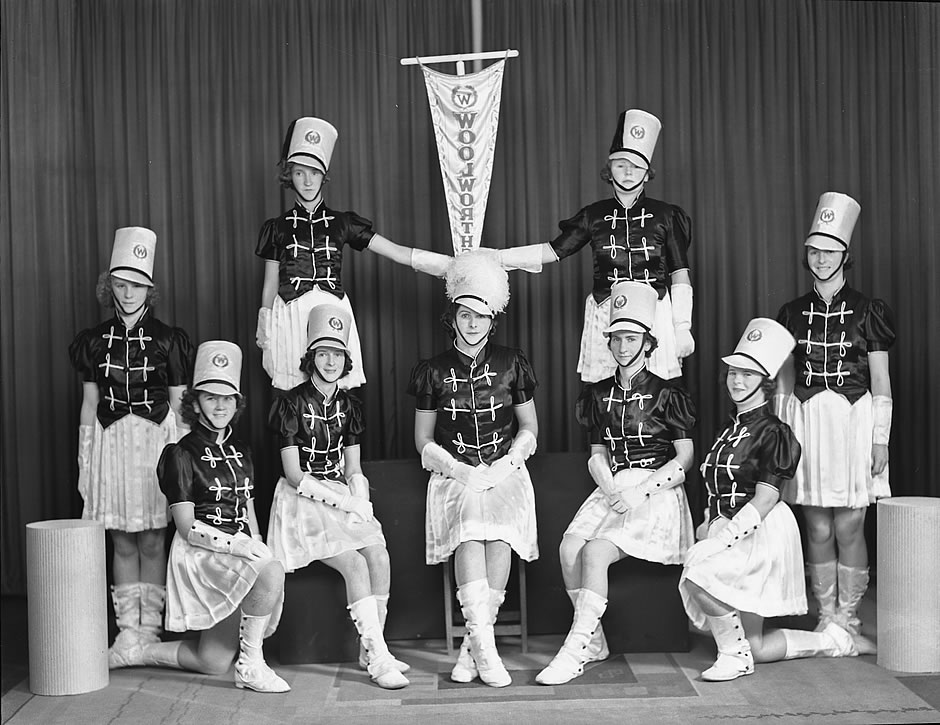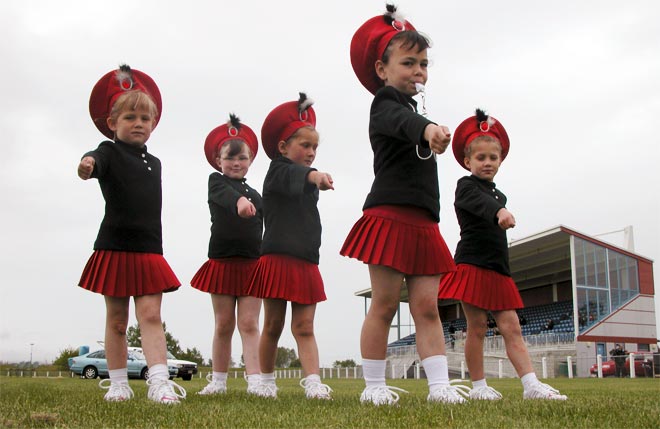
Marching New Zealand
1945 –
Theme: Sport and recreation
Known as:
- New Zealand Marching and Recreation Association
1945 – 1948 - New Zealand Marching Association
1948 – 1998 - Marching New Zealand
1998 –
This essay written by Jill Williams, Val Browning and Charlotte Macdonald was first published in Women Together: a History of Women's Organisations in New Zealand in 1993. It was updated by Diane Gardiner and Charlotte Macdonald in 2018.
From its founding, the main aims of the New Zealand Marching Association (NZMA) were to promote, encourage and control the sport of marching. In later decades, the association focused on providing opportunities for participation and on maximising the enjoyment of those taking part. In 1992 the NZMA comprised 21 local associations, 31 clubs, 2328 marchers, and 1222 coaches, judges, chaperones and other administrators.
Competitive and team marching first became popular in the 1930s, when teams of young women from the armed forces, factories, shops, and other workplaces around the country extended formation marching from a preliminary to team games to an activity in its own right. [1] Their uniforms were anything that was surplus, or whatever clothing coupons could buy. Marching became part of the regular inter-house competitions held at various centres around the country.
Local marching associations soon formed, mostly in the North Island, and a national marching organisation was founded in 1943. [2] Two years later the New Zealand Marching and Recreation Association was inaugurated on VJ Day (15 August 1945) at a meeting in Wellington attended by representatives of seven local associations. [3] Miriel Woods, a representative of the Timaru association and a Physical Welfare officer, was the only woman present. From the outset the association had the wholehearted support of the government. Minister of Internal Affairs William Parry and Assistant Under-Secretary Arthur Harper took a personal interest, and the department's Physical Welfare Branch gave assistance. [4]
At the end of World War II, many army officers and drill sergeants returned home and were drawn into the sport as instructors and judges, adapting their methods of army drill to competition marching. They saw marching's potential as an organised popular recreation for girls and young women.

Nelson Provincial Museum, Kingsford Collection: 158841
Woolworths marching team, Nelson, 1939. Working women’s sports teams flourished in the 1930s and 1940s, especially in large workplaces. While much of the enthusiasm came from the women themselves, many employers promoted physical welfare as part of their industrial efficacy programmes.
The association organised the first New Zealand championships in Timaru in 1946. Teams of ten (three ranks of three with a leader, replacing the original two ranks of four plus leader) competed, following a set march plan and accompanied by brass and pipe bands. This was a modified form of marching, more feminine in style than the original rigid military drill. The national organisation was renamed the New Zealand Marching Association in 1948. [5]
The number of marching teams and regional 'centres' (administrative bodies) grew rapidly: by 1951 over 300 teams were competing in several age grades in twenty affiliated centres. The main events in the marching calendar were soon established: centre championships, followed by North Island, South Island and national championships, at which only senior teams competed initially. In 1957 junior teams (aged 12–15) were included, followed by Midgets (aged 8–11) in 1968. In 1951 the monthly magazine Quick March was launched.
As well as marchers, competitive marching required instructors, managers, chaperones, judges and others to help with fundraising, catering and transport. These positions were filled largely by returned army personnel and parents. Every team was required to have at least one chaperone present at competitions, and preferably also at every team practice.
Judging in the early years was somewhat casual, and judges were supplied with only a few simple guidelines. As the sport progressed, a more detailed and precise system was required. The association introduced a graduated system of examinations for judges, but did not produce a 'Manual of Judging' until 1969.
Because marching was a uniquely New Zealand sport, there was no international competition, although teams toured overseas giving displays in England, Scotland and Australia; the first to do so was Dunedin's Blair Athol, which travelled to the UK in 1952. A New Zealand marching team later took part three times in the Edinburgh Tattoo, and was invited back in 1993. Early visits to Australia by New Zealand teams enabled interest in the sport to develop there, and the Australian Girls' Marching Association was formed in 1946. In 1977 Australia and New Zealand competed in the first Inter- Dominion Championship, held in Wellington. But by the late 1980s, the detail and style of Australian marching had changed, making equitable competition impossible. The governing bodies of both associations met in July 1992 to find some common ground for negotiating future competitions between the two countries. This was achieved, and the first 'International Challenge' was held in Adelaide in April 1993.
The 1970s and 1980s saw considerable changes in marching. Competition at the most senior level became extremely intense, requiring a high standard of performance and a heavy investment of time, effort and money by team members, instructors and supporters. For successful teams, such as Wellington's Lochiel or Auckland's Continental Guards, the rewards were considerable. Increasingly these included overseas tours and performances at prestige events such as the 1990 Commonwealth Games. At the other end of the scale, the young were encouraged to take up marching through the Introductory grade (open to girls from the age of six) and experience at primary school: marching was accepted as a 'KiwiSport' in 1990.
In the championships, the detail of drill and the requirements for the Display of Marching Section were changed and updated. Allowing teams to choose their own music for their displays gave them scope for more creativity and flair, and greater public appeal. In addition, teams were able to use accessories to enhance their display.
From about 1980, however, the association's membership declined, and the number of teams dropped from 368 in 1974-75 to 186 in 1991–92. Encouraging girls to stay on at the senior level became particularly difficult, as did recruiting sufficient instructors, judges and chaperones. Changes made within the organisation to stimulate growth included reducing the number of administrative levels in 1986 from four to three (national association, local association and club), obtaining an annual grant from the Hillary Commission to cover the salary of an executive director, and negotiating a major sponsorship contract. Attracting sponsorship for the major championships became increasingly important, both for the NZMA and for individual teams. [6] In November 1993, marching was given the stamp of approval by NZ Post, with the issue of a $1 stamp depicting ‘marching girls’ of the 1940s.
Jill Williams, Val Browning and Charlotte Macdonald
1994 – 2018
Marching faced stiff competition from other sports and claims on people’s time, but following the decline in membership numbers during the 1980s, over the next twenty years marching stabilised its position. In 2017–2018 there was an increase in registered members for the first time in a number of years. [7] It remained mainly a team sport played by women, though boys and men joined team ranks in the under-16 years and Masters grades, and the organisation continued to involve men in management and judging roles.
From 1998 the organisation became known as Marching New Zealand (MNZ). The core activities remained the same: to promote competitive and recreational marching as a popular sport for women and girls. The Masters Grade was introduced in 1994, and further revisions to grades reflected the changing composition of the marching community, with both recreational and competitive teams encouraged by local associations. In the 2000s an Open Free Choice Grade, with a strong emphasis on participation, was introduced, open to non-competitive teams to perform their own choice of routine to their own choice of music.

Otago Daily Times, 6 Nov 2006, p. 12. (Sourced from Te Ara)
The Kiwis marching team, consisting of girls under the age of eight, practising in 2006.
Team structure also changed to be more flexible, though the traditional ten-person marching team of a leader and three ranks of three remained. Options where teams could march with lower numbers kept the sport viable in smaller, less populated areas. By 2018 teams no longer marched to the accompaniment of brass and pipe bands, instead marching at 120 beats in the set plan phase and then to more trendy music of their own choice in the display phase, where teams showed their flamboyancy and creativeness.
A much stronger emphasis on legal compliance in matters such as health and safety added to the administrative requirements of running the organisation, both locally and at the national level. Attracting suitable candidates to ‘volunteer’ for such work added greatly to the demands made on members’ relatives and supporters. Technology, while adding benefits, also added to the pressure, with volunteers needing to keep up with it.
To survive in the modern era, marching had to reconsider its structure and how it presented the sport, in terms of not only appealing to its increasingly time-poor participants, but also recognising that the adjudication system needed to be relatively simple to be easily understood and managed, in order to cope with the numbers of marchers varying between teams (from seven to fourteen, depending on the phase – Technical Drill or Display). Marching New Zealand concluded that introducing the guideline of being a performance sport would best capture both the competitive and recreational elements.
By 2018 the number of associations had decreased, although an even spread remained across the country from north to south, with ten association committees administering and presenting the sport for participants. Many of the judges and coaches were long serving in the sport; such loyalty was a strong value of which the associations and the national organisation were very proud.
Being a ‘home grown’ sport, unique to New Zealand, marching had no international affiliation. However, South Africa and the USA, similarly structured performance sports could provide opportunities for teams to travel and perform internationally, though not to compete. As of 2018, no International Challenge competition with Australia had been held since 1997, though New Zealand teams had performed at Australian events.
The most recognised public face of marching from 2000 became Wellington’s Lochiel Marching Drill Team. The oldest established precision marching team in New Zealand, they had formed in the late 1950s. Skellerup of Christchurch and Bandolier of Wellington were also long-established teams, both having reached their 50 year milestones, and all retaining former members in team management positions as coaches.
Lochiel were lead performers at the presentations of the Edinburgh Military Tattoo held at Westpac Trust Stadium in Wellington in 2000 and in 2016, and they also attended Tattoo performances in Melbourne. They performed regularly on the international stage, being invited to the Edinburgh Tattoo in Scotland on seven occasions, as well as to other international festivals in South Africa, Switzerland, Denmark, the Netherlands, Norway and Nova Scotia. [8]
Other teams also received invitations to perform overseas: Temuka Militaires Junior Team of Timaru attended Chingay Festival in Singapore, and Shevarn of Auckland represented NZ at the Kurumayam-Kogen Southern Crossing Festival in Nagano, Japan. Pioneers of Canterbury attended the Brisbane Festival 2000 International Tattoo in Australia, and in 2012 they went to the Canadian International Military Tattoo in Hamilton, Ontario.
In 2018 marching remained an amateur sport, administered by volunteers who were committed to contributing to the health and wellbeing of all New Zealanders, and determined to stay within reach of as many participants as possible.
Diane Gardiner [9] and Charlotte Macdonald
Notes
[1] It is not clear when the first marching team formed, or when the first marching competition took place. Quick March reported in its first issue that marching displays were given 'as long ago as 1928', but the real era of inter-house sports and formation marching was the 1930s and early 1940s. See Quick March, No. 1, November 1951; Coney, 1986, chapter 6.
[2] Dates for the formation of the NZMA are confusing. Sources within the association give 1943 as the year when the initial organisation was formed, and 1945 as the year it was incorporated.
[3] The seven associations were Wellington, Timaru, Wanganui, Wairarapa/Martinborough, Hastings, Napier, Pahiatua/Palmerston North.
[4] Harper was present at the inaugural meeting of the NZMRA, while Parry donated a trophy for the Championship team.
[5] 'Premier praises N. Z. Marching Association'. Gisborne Herald, 16 Aug 1948, p. 8. (PapersPast)
[6] In the 1980s, the complex sponsorship arrangements negotiated by individual teams resulted in ever-lengthening team names, creating havoc at championships. The NZMA subsequently ruled that team names were to be no longer than five words.
[7] Annual Report, Marching New Zealand, 2017–18, June 2018. Available from http://www.marching.co.nz/assets/Uploads/ANNUAL-REPORT-2018.pdf
[8] http://www.marching.co.nz/
[9] CEO, Marching New Zealand.
Unpublished sources
New Zealand Marching Association records, 1945– , NZMA National Office, Wellington
Published sources
Mangos, Norma, and Janice Stayt (compilers), Marching Down Under, NZMA National Office, Wellington; Gardiner, Diane, Supplement, 2000
Quick March, 1951–1963; Quick Step, 1963–1992
Newsletters, www.marching.co.nz

Community contributions